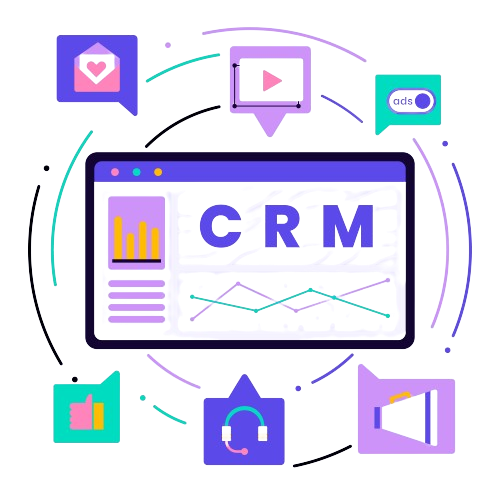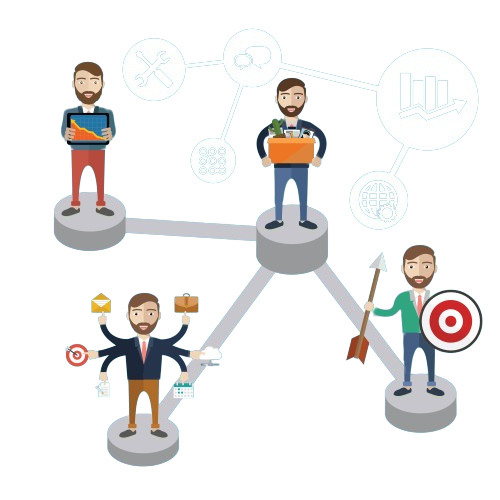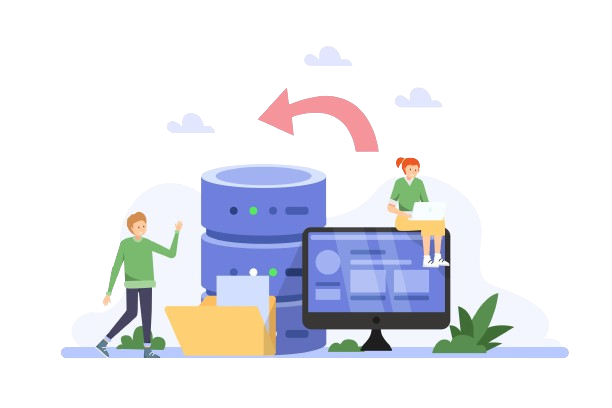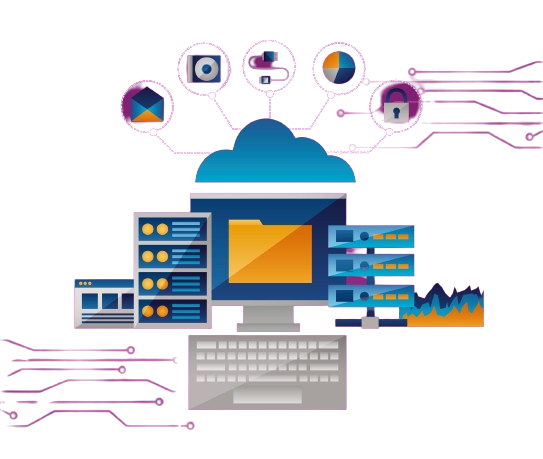
In short, choosing a suitable CRM software and checking the features of CRM software to ensure that it will go well with your customer engagement requirements.
Businesses are recognizing the importance of integrating various channels to create a cohesive and unified experience for their customers. This integration, known as cross-channel integration, plays a pivotal role in modern CRM strategies, reshaping the way organizations interact with and understand their customers.
Cross-channel integration refers to the seamless connection and coordination of various communication and interaction channels within a CRM system. These channels can include, but are not limited to, email, social media, mobile apps, websites, and in-person interactions. The goal is to break down silos and create a unified environment where data and insights can flow seamlessly across all touchpoints.
In simpler terms, it’s about ensuring that whether a customer interacts with a brand through email, social media, a website, or a physical store, the information and experience they receive remain consistent and interconnected. This level of integration goes beyond merely using multiple channels; it involves synchronizing data, processes, and communication strategies to provide a holistic view of the customer journey. In short, choosing a suitable CRM software and checking the features of CRM software to ensure that it will go well with your customer engagement requirements.
The Role of Integration in Modern CRM Strategies

Integration has become a cornerstone of modern CRM strategies, and for good reason. In an era where customers expect personalized and consistent experiences across all channels, businesses need to adapt their CRM systems to meet these expectations. Here’s a closer look at the key roles that integration plays:
- Unified Customer View: Integration allows businesses to consolidate customer data from various touch points into a centralized database. This unified customer view provides a comprehensive understanding of each customer’s interactions, preferences, and history with the brand.
- Enhanced Customer Engagement: By connecting different communication channels, businesses can create more targeted and personalized engagement strategies. For example, data from a customer’s social media interactions can inform email campaigns, creating a more cohesive and engaging customer experience.
- Efficient Data Flow: Integration ensures the smooth flow of data between different departments within an organization. For instance, sales teams can have real-time access to customer support interactions, enabling them to tailor their approach based on the customer’s recent experiences.
- Consistent Messaging: A key benefit of cross-channel integration is the ability to maintain consistent messaging and branding across all platforms. This consistency fosters trust and reinforces the brand identity in the eyes of the customer.
- Adaptability to Customer Preferences: Integrated CRM systems can adapt to customer preferences and behavior. For instance, if a customer prefers receiving updates via email rather than social media, the CRM system can adjust communication strategies accordingly.
- Improved Decision-Making: Integration provides a wealth of data that can be analyzed to gain insights into customer behavior, campaign effectiveness, and overall business performance. This data-driven approach empowers businesses to make informed decisions and optimize their strategies.
- Scalability and Future-Proofing: As businesses grow and adopt new channels, an integrated CRM system can easily scale to accommodate these changes. This scalability ensures that the CRM strategy remains effective and adaptable to evolving customer preferences and industry trends.
The introduction of cross-channel integration in CRM is a response to the evolving nature of customer interactions.
The Importance of Seamlessness

The importance of seamlessness in cross-channel integration cannot be overstated. This facet is not merely a technological convenience but a strategic imperative that significantly influences user experience and, consequently, the success of CRM strategies. Let’s discuss the intricacies of why seamlessness is a pivotal aspect when connecting platforms within the CRM ecosystem.
Understanding the Need for Seamless Connections
- Holistic Customer View: Seamless connections across various channels enable businesses to create and maintain a holistic view of their customers. In an era where customers engage with companies through multiple touchpoints, from social media to email and in-store visits, a seamless integration of data ensures that every interaction contributes to a comprehensive understanding of individual customer preferences, behaviors, and needs.
- Data Consistency and Accuracy: Seamlessness in integration directly impacts the consistency and accuracy of data. When platforms seamlessly communicate and synchronize information, it reduces the likelihood of discrepancies or outdated data. This, in turn, empowers businesses to make informed decisions based on real-time, reliable information, enhancing the overall effectiveness of their CRM efforts.
- Operational Efficiency: A seamless integration of platforms streamlines operational processes. This efficiency not only saves time but also minimizes the risk of errors associated with manual data entry or disconnected systems. Automated workflows, triggered by seamless integration, enable teams to focus on strategic initiatives rather than mundane, repetitive tasks.
- Real-time Responsiveness: Customer expectations in the digital age demand real-time responsiveness. A seamless integration ensures that data updates instantaneously across all relevant channels, allowing businesses to respond promptly to customer inquiries, address concerns, and capitalize on emerging opportunities. This agility is paramount in today’s fast-paced business environment.
Enhancing User Experience Through Integration
- Unified Customer Interactions: A seamless integration of features of CRM software enables businesses to provide a unified experience for customers. Whether a customer is interacting with a brand through a website, mobile app, or social media, a seamless integration ensures that the brand communicates consistently and cohesively, fostering trust and loyalty.
- Personalized Engagement: Integrating data from various channels allows businesses to personalize their interactions with customers. By understanding customer preferences and behaviors across different touchpoints, businesses can tailor their communications, offers, and recommendations. This level of personalization enhances the user experience, making customers feel valued and understood.
- Reduced Friction in Customer Journeys: Seamless integration minimizes friction in customer journeys. A customer should be able to transition between channels without encountering disruptions or inconsistencies. Whether they start their journey on a website and later switch to a mobile app, the integration ensures a smooth and continuous experience, contributing to higher satisfaction and engagement.
- Multi-Channel Marketing Effectiveness: For marketing strategies to be effective, they need to be cohesive across various channels. A seamless integration of features of CRM software facilitates coordinated marketing efforts, ensuring that messages are aligned and complementary across email, social media, and other channels. This consistency enhances the impact of marketing campaigns and strengthens brand messaging.
- Improved Customer Retention and Loyalty: The user experience plays a pivotal role in customer retention and loyalty. When businesses provide a seamless and personalized experience, customers are more likely to stay engaged and loyal. Seamless integration contributes to building long-term relationships by making every interaction with the brand positive, efficient, and tailored to individual preferences.
Seamlessness is a fundamental driver of enhanced user experiences, operational effectiveness, and, ultimately, the success of CRM strategies. Businesses that prioritize and invest in seamless connections across platforms are better positioned to meet the evolving expectations of their customers and navigate the complexities.
Key Platforms in Cross-Channel Integration
 Cross-channel integration is a crucial aspect of modern business strategies, bringing together various platforms to create a unified and seamless experience for both businesses and customers. As organizations strive to streamline their operations and improve customer interactions, the selection of the right platforms for cross-channel integration becomes paramount.
Cross-channel integration is a crucial aspect of modern business strategies, bringing together various platforms to create a unified and seamless experience for both businesses and customers. As organizations strive to streamline their operations and improve customer interactions, the selection of the right platforms for cross-channel integration becomes paramount.
- CRM Systems: The Nucleus of Cross-Channel Integration
- Salesforce: The Pioneer of Integrated CRM
- HubSpot: Inbound Marketing Meets Integration
- Zoho CRM: Bridging the Gap Across Channels
- EQUP: Elevating CRM with Advanced Analytics
- Marketing Automation Platforms: Orchestrating Campaigns Across Channels
- HubSpot Marketing Hub: Integration with Purpose
- Mailchimp: Email Marketing in the Cross-Channel Mix
- EQUP: Advanced Analytics Enhancing Marketing Insights
- E-commerce Platforms: Bridging the Gap Between Sales Channels
- Shopify: Seamlessly Integrating Sales Data
- Magento: Elevating E-commerce with CRM Integration
- EQUP: Augmenting E-commerce Insights with Analytics
- Analytics Solutions: Deriving Insights from Integrated Data
- Google Analytics: Unifying Web Insights with CRM Data
- Tableau: Visualizing Integrated Data for Informed Decision-Making
- EQUP: Elevating Analytics for Comprehensive Business Insights
Data Synchronization Across Channels
 Data synchronization, the process of harmonizing data across different platforms, is a critical aspect of a seamless and effective CRM strategy. In this section, we’ll explore the significance of ensuring consistent information and explore strategies for effective data synchronization.
Importance of Consistency in CRM Data
Consistency in CRM data is fundamental to delivering a unified and positive customer experience. When customer data is consistent across channels, it fosters trust and credibility. Inconsistencies, such as conflicting information about a customer’s preferences or purchase history, can lead to confusion and frustration, potentially jeopardizing the customer relationship.
Data synchronization, the process of harmonizing data across different platforms, is a critical aspect of a seamless and effective CRM strategy. In this section, we’ll explore the significance of ensuring consistent information and explore strategies for effective data synchronization.
Importance of Consistency in CRM Data
Consistency in CRM data is fundamental to delivering a unified and positive customer experience. When customer data is consistent across channels, it fosters trust and credibility. Inconsistencies, such as conflicting information about a customer’s preferences or purchase history, can lead to confusion and frustration, potentially jeopardizing the customer relationship.
- Building Trust and Credibility:
- Consistent data reinforces trust in your brand as customers perceive you as reliable and organized.
- Trust is a cornerstone of long-term customer relationships, and consistency in data instills confidence in your organization’s professionalism.
- Enhancing Personalization:
- Personalized experiences hinge on accurate and consistent customer data.
- Inconsistencies can disrupt personalization efforts, leading to irrelevant communications that may alienate customers.
- Facilitating Informed Decision-Making:
- Consistent data provides a clear and accurate picture of customer behavior and preferences.
- Informed decision-making relies on the availability of reliable data, enabling businesses to tailor strategies to customer needs effectively.
- Improving Operational Efficiency:
- A consistent data environment streamlines internal processes, reducing the likelihood of errors and redundancies.
- Efficient operations contribute to a more agile and responsive business, ultimately benefiting the customer experience.
- Implementing Centralized Data Storage:
- Centralizing customer data in a master repository ensures that information is uniform and accessible across channels.
- A centralized system minimizes the risk of data silos and facilitates easier synchronization.
- Utilizing Automation for Real-Time Updates:
- Implement automation tools to update data in real-time across different platforms.
- Automation reduces the reliance on manual processes, minimizing the chances of errors and ensuring swift updates.
- Establishing Data Governance Policies:
- Develop clear data governance policies outlining data standards, protocols, and ownership.
- Standardized data governance ensures that everyone in the organization follows consistent practices when updating and accessing customer information.
- Leveraging Integration Platforms:
- Integrate CRM systems with other business applications using dedicated integration platforms.
- Integration platforms enable seamless communication between different software solutions, ensuring data synchronization without manual intervention.
- Regular Data Audits and Quality Checks:
- Conduct regular audits to identify inconsistencies and inaccuracies in the data.
- Implement quality checks and validation protocols to maintain data accuracy and integrity.
- Prioritizing Security and Compliance:
- Implement robust security measures to safeguard customer data during synchronization.
- Ensure compliance with data protection regulations to build customer trust and avoid legal issues.
- Employee Training and Awareness:
- Train employees on the importance of data consistency and the role they play in maintaining it.
- Foster a culture of data responsibility to ensure that all team members understand the impact of their actions on data integrity.
Customer Journey Mapping with Integrated Platforms
 Customer journey mapping is a visual representation of the various touchpoints a customer encounters across multiple channels during their interaction with a brand. These touchpoints encompass every stage of the customer’s lifecycle, from initial awareness to post-purchase engagement. Traditionally, customer journey mapping has been a valuable exercise for businesses seeking to understand the customer experience. However, the true power of customer journey mapping is unlocked when it is seamlessly integrated across multiple platforms.
The Role of Cross-Channel Integration
Cross-channel integration involves connecting different platforms and channels seamlessly within a business ecosystem. When applied to customer journey mapping, this integration allows for a holistic and real-time view of customer interactions. This means that data collected from various touchpoints, such as social media, email, website interactions, and customer service, can be aggregated and analyzed in a unified manner.
Enhancing Customer Interactions
Customer journey mapping is a visual representation of the various touchpoints a customer encounters across multiple channels during their interaction with a brand. These touchpoints encompass every stage of the customer’s lifecycle, from initial awareness to post-purchase engagement. Traditionally, customer journey mapping has been a valuable exercise for businesses seeking to understand the customer experience. However, the true power of customer journey mapping is unlocked when it is seamlessly integrated across multiple platforms.
The Role of Cross-Channel Integration
Cross-channel integration involves connecting different platforms and channels seamlessly within a business ecosystem. When applied to customer journey mapping, this integration allows for a holistic and real-time view of customer interactions. This means that data collected from various touchpoints, such as social media, email, website interactions, and customer service, can be aggregated and analyzed in a unified manner.
Enhancing Customer Interactions
- Unified Customer Profiles: With cross-channel integration, customer data is consolidated into unified profiles. This includes preferences, purchase history, interactions, and feedback. Having a centralized repository of customer information enables businesses to create more accurate and comprehensive customer personas.
- Personalized Communication: Integrated platforms allow for the seamless flow of information across channels. This, in turn, enables businesses to personalize their communication with customers. For example, a customer who has recently made a purchase online might receive targeted emails or advertisements related to complementary products or exclusive offers.
- Real-Time Insights: Integrated platforms provide real-time insights into customer behavior. Businesses can track a customer’s journey in real-time, allowing for timely interventions or personalized responses. For instance, if a customer abandons a shopping cart, an integrated system can trigger an automated follow-up email with incentives to complete the purchase.
- Consistent Brand Experience: Cross-channel integration ensures a consistent brand experience across various touchpoints. Whether a customer interacts with your brand through social media, email, or in-store, they should experience a cohesive and uniform representation. This consistency builds trust and strengthens brand loyalty.
- Efficient Issue Resolution: Integrated data facilitates more efficient issue resolution. Customer service representatives can access a customer’s entire interaction history, enabling them to understand the context of the inquiry and provide faster and more personalized solutions.
- Choose CRM and marketing automation platforms that are compatible and support seamless integration. Ensure that these platforms can communicate effectively to share and update customer data.
- Standardize data formats and fields across platforms to facilitate smooth data exchange. Consistent data standards prevent discrepancies and inaccuracies in customer information.
- Implement automated workflows that trigger actions based on customer interactions. For instance, an e-commerce platform can automatically update a customer’s profile and initiate a personalized email campaign after a purchase.
- Conduct regular audits of integrated data to identify and rectify any discrepancies. This ensures that the customer data remains accurate and reliable.